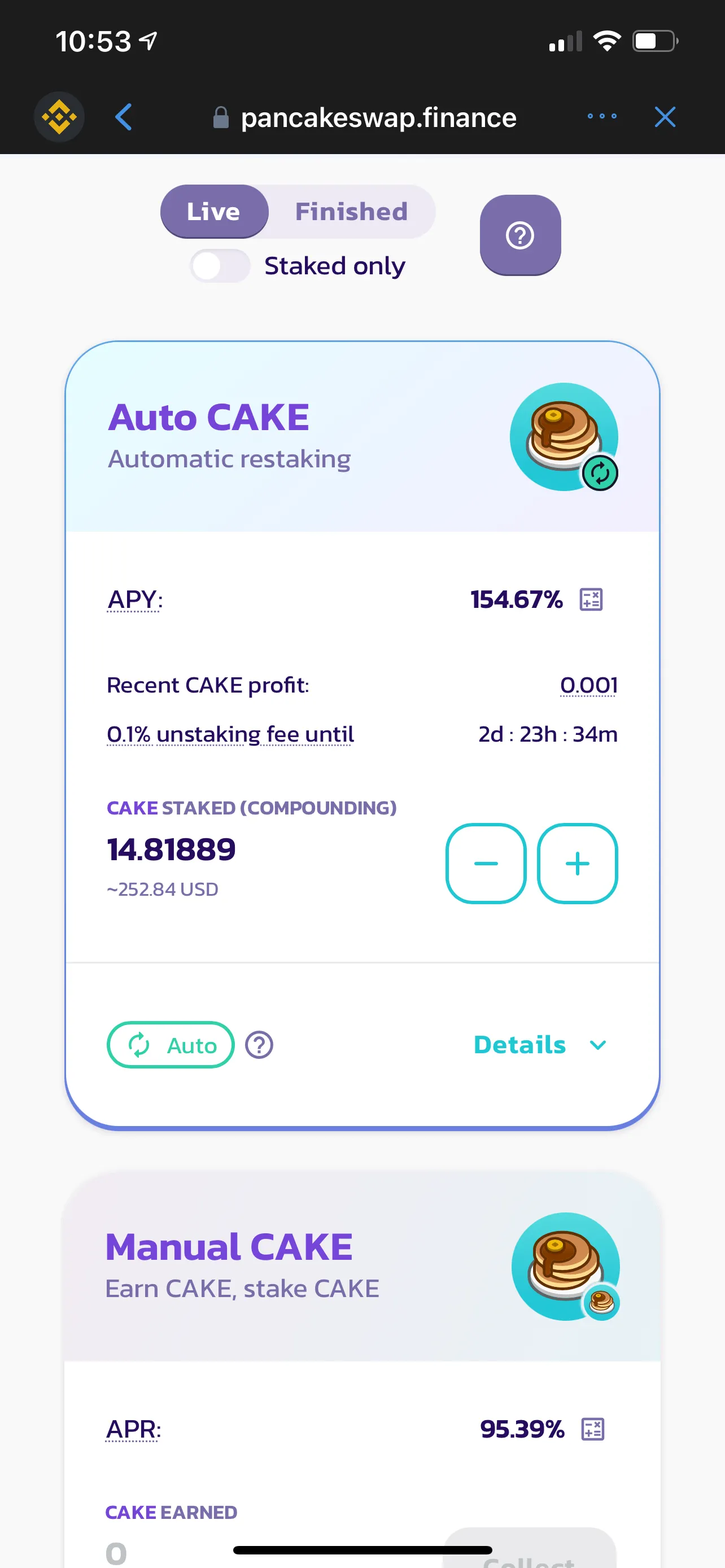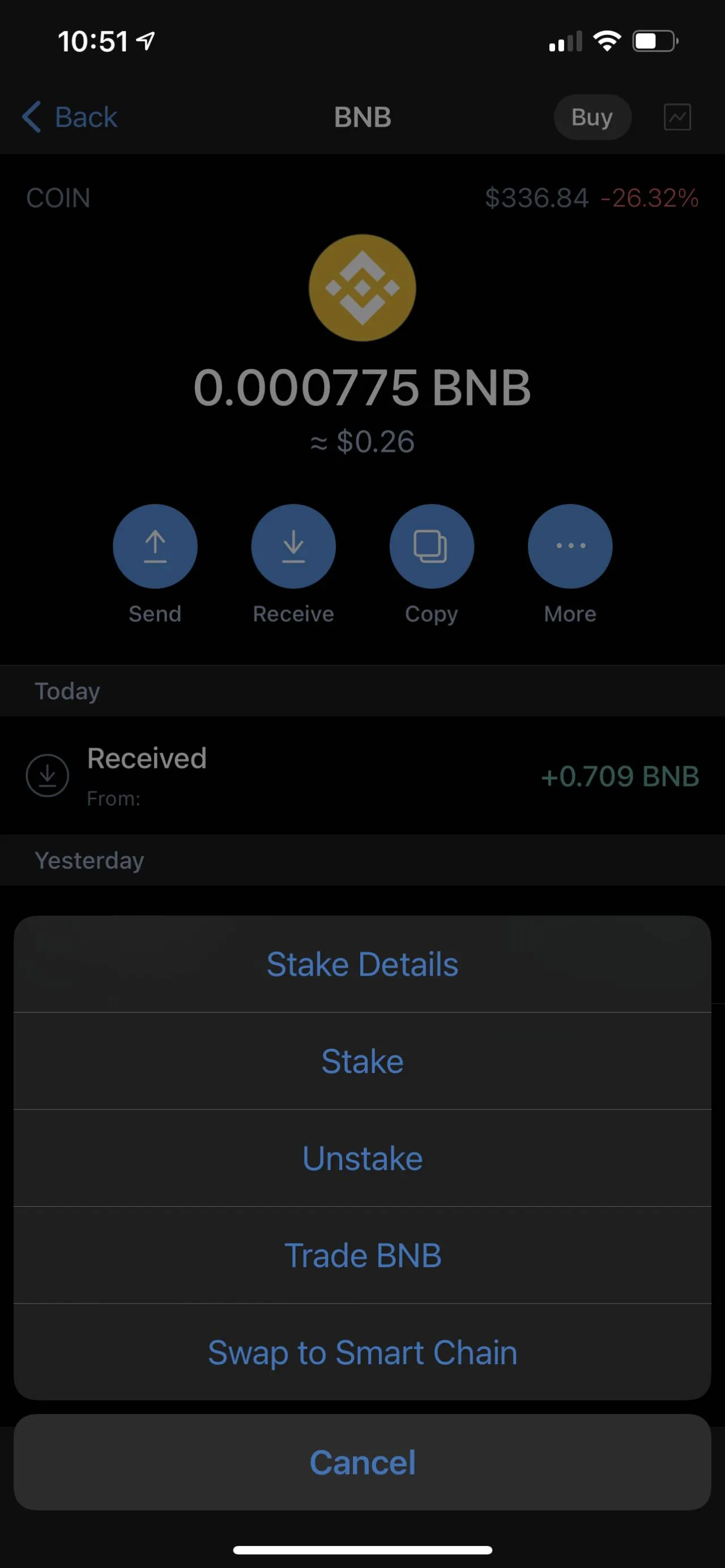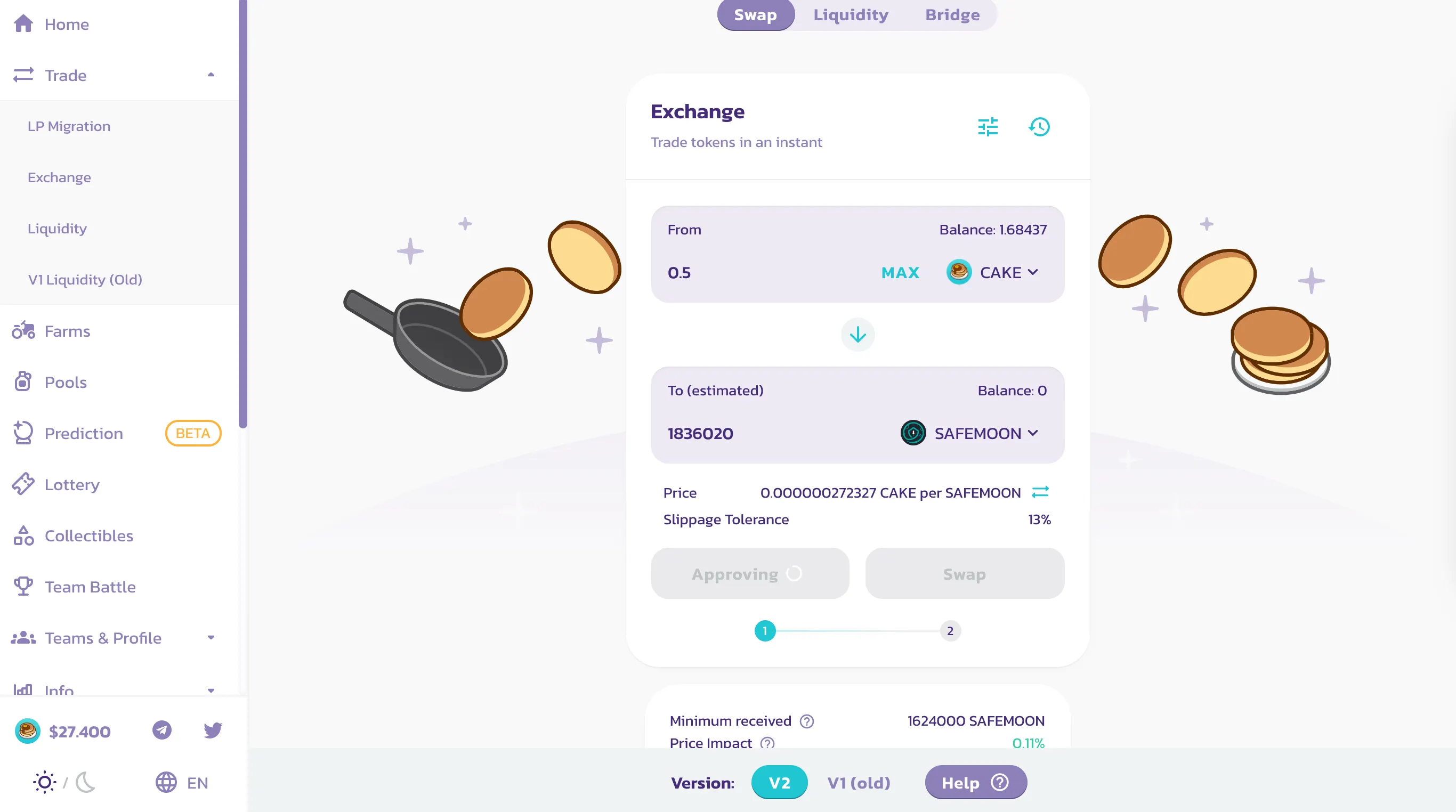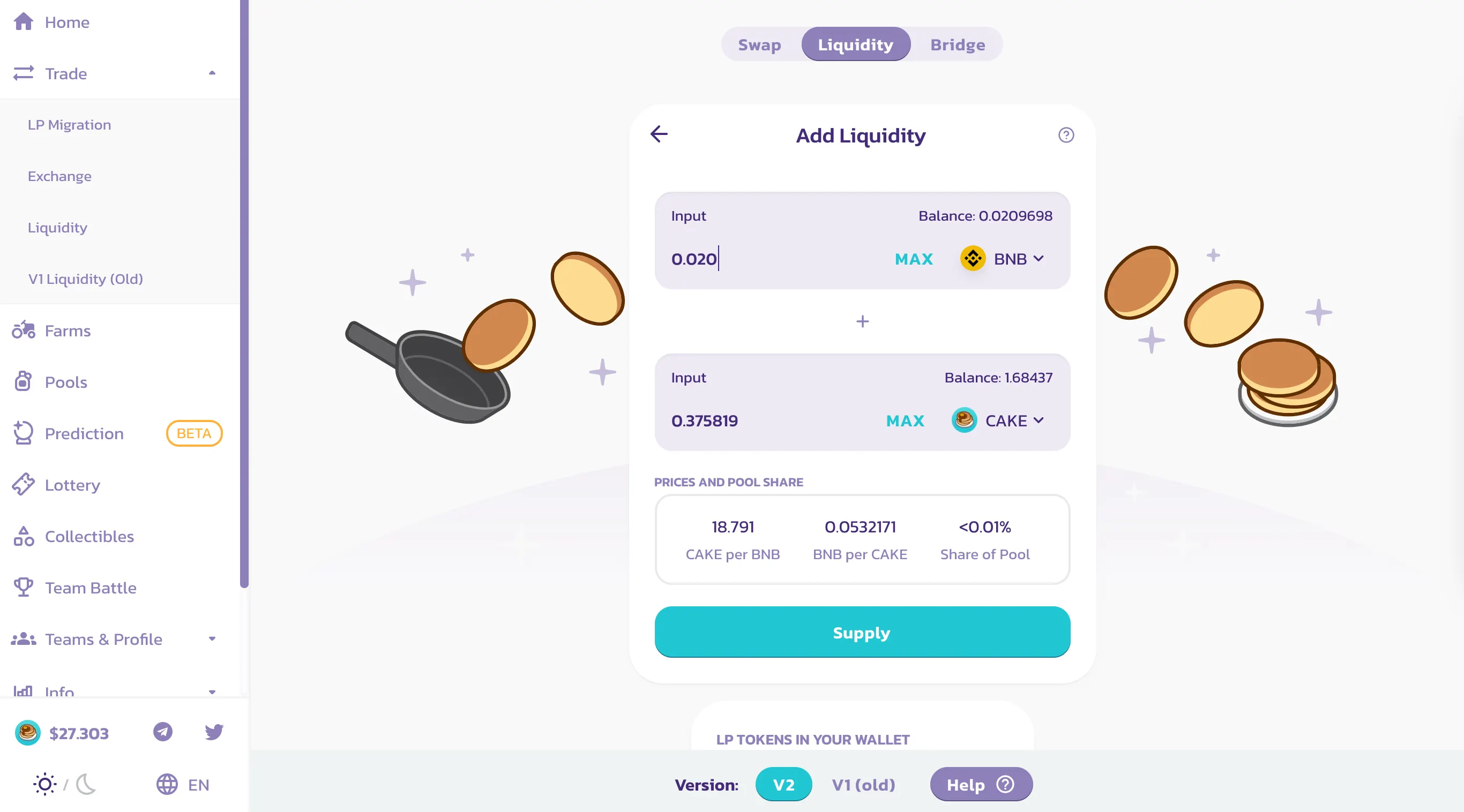In brief
- PancakeSwap is a decentralized exchange that is similar to Ethereum’s Uniswap, but it runs on Binance Smart Chain instead.
- The DEX lets you swap tokens without an intermediary, as well as earn liquidity pool and staking rewards, enter a lottery, and other options.
Unlike popular, centralized cryptocurrency exchanges like Binance and Coinbase that are operated by a single, corporate entity, decentralized exchanges (DEXs) allow for trading without an intermediary. Many such DEXs are based on Ethereum, where the bulk of the decentralized finance (DeFi) action takes place.
However, as rival smart contract blockchains take root, comparable DEXs are springing up elsewhere, sometimes with unique twists. In the case of PancakeSwap, it’s built on Binance Smart Chain rather than Ethereum, and offers much lower trading fees as a result. Binance Smart Chain is newer and less established than Ethereum, but PancakeSwap is already making major waves among DEXs.
Here’s what you need to know about PancakeSwap on the Binance Smart Chain, including a quick primer on how to get started.
What is PancakeSwap?
PancakeSwap is a decentralized exchange that allows you to trade cryptocurrencies and tokens without a centralized intermediary, keeping custody of your tokens all the while. It is built on automated smart contracts deployed on Binance Smart Chain, the blockchain platform run by crypto exchange Binance.
Even though Binance operates a centralized exchange service, it does not control or operate PancakeSwap—it was built by anonymous developers. The service looks and feels very similar to the popular Ethereum DEX, Uniswap. PancakeSwap is used specifically for BEP-20 tokens running on Binance Smart Chain, although it’s possible to bring over tokens from other platforms via Binance Bridge and “wrap” them as a BEP-20 token for use on the DEX.
Like many other DEXs, PancakeSwap is built on an automated market maker (AMM) system, which relies on user-fueled liquidity pools to enable crypto trades. Rather than dealing with an order book and finding someone else who wants to swap the tokens you have for the ones you want, users lock their tokens into a liquidity pool via smart contracts. That allows you to make the swap you want, and users who keep their coins in the pool earn rewards all the while.
PancakeSwap is part of the rising wave of DeFi services that enable crypto traders to conduct transactions with trade tokens without a middleman taking a significant cut of the funds. It is one of the largest such DEXs on the Binance Smart Chain, although there are DEXs on Ethereum (such as Uniswap) with significantly higher average trading volume.
Did you know?
PancakeSwap has flipped Uniswap on multiple occasions to become the most popular DEX based on trading volume, but hasn’t consistently maintained that title as of yet.
How does PancakeSwap work?
As described above, token swaps take place via liquidity pools between token pairs. Users are able to exchange one type of token for another without an intermediary, while other users who stake their tokens in the liquidity pools earn a share of the rewards generated by transactions.
However, that’s just one part of the overall PancakeSwap experience. The DEX also lets you stake coins into so-called Syrup Pools that provide growing rewards. For example, you can stake CAKE, PancakeSwap’s native token, and earn even more CAKE just by letting it sit there in the Syrup Pool over time. There’s even an auto-stake option that will re-stake your CAKE at least once per hour, continuously compounding your rewards.

PancakeSwap offers game-like experiences, such as wagering on whether the price of Binance Coin (BNB) will rise or fall within a limited window of time. It also has a lottery feature that lets users buy a ticket in hopes of winning a major windfall of CAKE, plus the DEX offers a wide array of bunny-themed collectible non-fungible tokens (NFTs) to purchase. There are also Initial Farm Offering (IFO) sales that let you buy brand new coins from budding projects.
Did you know?
PancakeSwap is the latest in a long line of food-themed crypto projects, including SushiSwap, Yam Finance, BakerySwap, and Kimchi Finance.
What’s so special about it?
PancakeSwap cuts out the middlemen of centralized exchanges, letting other users reap the rewards instead. If you’re willing to lock up your tokens for a while, the rewards can be very plentiful, particularly with some of the liquidity pools and staking options.
Granted, as with other DEXs, crypto newbies will likely struggle to navigate PancakeSwap and understand its myriad features. It could be worth your while to take the time to figure it out, though.
A beginner’s guide to using PancakeSwap
You will need your own crypto wallet to use PancakeSwap, as the DEX does not support fiat currency. PancakeSwap works with wallets such as Trust Wallet, MathWallet, Binance Chain Wallet, and even MetaMask. Yes, MetaMask is an Ethereum wallet, but it can be configured to work with Binance Smart Chain. Unlike centralized exchanges, you won’t have to input a bunch of personal data—you don’t even have to create a profile.
Decrypt opted to use Trust Wallet on a smartphone. The first step is to purchase some Binance Coin (BNB) from Binance.US and transfer it to your wallet. Then you'll need to convert it to Binance Smart Chain to use it at PancakeSwap. You can do that within Trust Wallet by pressing the “More” button, tapping “Swap to Smart Chain,” and paying a small transaction fee to convert your coins.

All of PancakeSwap’s functions are shown on the left side of the screen in your web browser. To swap tokens, go to Trade and select Exchange, and then choose which token in your connected wallet you want to trade, for which supported token on the DEX. You will need to confirm the transaction within your wallet to execute it.

For farms, or liquidity pools, you must spend an equal value of tokens in a pair (such as CAKE-BNB) to purchase LP tokens, which provide liquidity to the DEX and earn you rewards in the process. This liquidity can be removed at any time, and will be disbursed in the individual tokens that were initially swapped for the LP tokens.

The future:
Binance Smart Chain is growing quickly as developers take advantage of its low fees and speedier transactions compared to Ethereum. In April 2021, Binance revealed that the platform had executed some 4.9 million transactions in a single day, or three times the amount that Ethereum has ever managed in a day.
Insane volumes over the past 24hrs.
ATH by far.https://t.co/exvpQR8hbZ pic.twitter.com/A50Re9bU4W
— PancakeSwap 🥞 #BSC (@PancakeSwap) May 20, 2021
PancakeSwap doesn’t have the same level of average daily volume as Uniswap or SushiSwap, Ethereum’s two biggest heavyweight DEXs, but it’s already very popular considering the relatively young age of Binance Smart Chain.
If Binance’s decentralized app (dapp) platform continues to grow and pull in more developers and users alike—and Ethereum’s soaring gas fees and network congestion continue—then PancakeSwap may well put up an even stronger fight against rival exchanges in time.
Disclaimer
The views and opinions expressed by the author are for informational purposes only and do not constitute financial, investment, or other advice.






